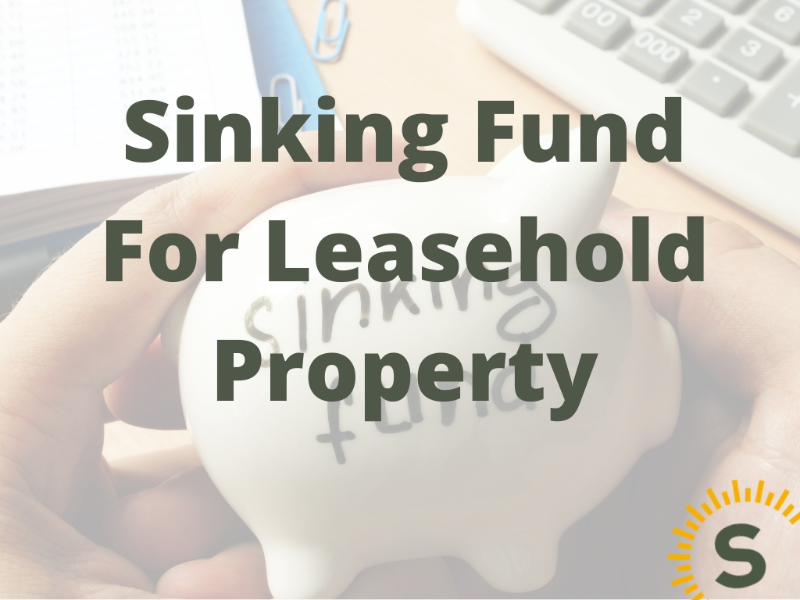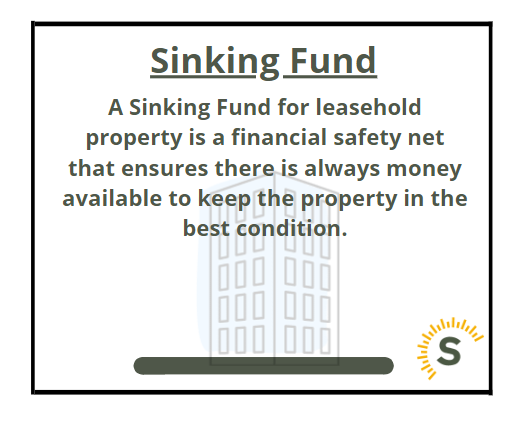
When it comes to leasehold properties, you may have heard of a fee called the "Sinking Fund." This fund receives contributions from all leaseholders, but what exactly is the sinking fund for leasehold property?
In this insight, we will cover what you need to know about your sinking fund.
A Sinking Fund for leasehold property is a financial safety net that ensures there is always money available to keep the property in the best condition. Should any significant work be needed, this fund is collected within the service charge, often included in leasehold property agreements and can be used for repairs.
The Sinking Fund is like a special bank account for future repairs in a property. Every leaseholder contributes to it through their fees. The money is saved separately, not controlled by the property management company. It's there to pay for big repairs when needed later on.

The Sinking Fund works simply like this: Every time you pay your fees, a certain amount is put aside for the fund. This money goes into a special account that earns extra money over time (interest). The interest is also added to the fund, making it grow bigger. So, when there are big expenses for the property later on, there's enough money in the fund to cover them.
The sinking fund contribution is not refundable, it is an ongoing contribution made by all members on a pro-rata basis depending on how long they stay as leaseholders. If you sell your lease you stop contributing but do not get any money back
The fate and purpose of the sinking fund depend on the leasehold property's management and the terms outlined in the lease agreement. Typically, the sinking fund is specifically designated for covering major repairs, maintenance, and capital expenditures related to the leasehold property.
The management of the sinking fund is usually overseen by a body or committee responsible for the leasehold property's upkeep. They carefully manage the funds, ensure they are used appropriately for the intended purposes, and keep a transparent record of all transactions related to the fund.
The sinking fund can be used to pay towards major repairs or replacing such things as:
If the fund is not used, it keeps earning interest and growing over time.
The service management company of the property decide how much money should be saved in the sinking fund. They think about how much it might cost to replace things like the door entry system and how long it will last before needing repairs. Then, they figure out how much money is needed each year and divide that amongst all the residents. They also think about other common repairs like drainage, lighting, footpaths, and roads when calculating the amount. This way, everyone contributes a fair share to the sinking fund to cover future expenses.
The primary benefit of a sinking fund is that it allows for planned, rather than unexpected, expenses for repairs. This pre-planning can be a financial relief to leaseholders, who might otherwise be caught off-guard by a large, sudden expense.
Furthermore, leasehold properties with a sinking fund may be more appealing to potential buyers. This is because the existence of a sinking fund may alleviate the buyer's concerns about significant future expenses related to property maintenance.
On the flip side, contributing to a sinking fund can increase annual costs. If the property does not require significant repairs or replacements, the money in the sinking fund may be seen as being underutilised. There may also be difficulties in retrieving the money if it has been paid into the fund but remains unused.
Disputes over sinking funds may also arise, where leaseholders question the management costs charged by the Managing Agents or allege that the funds have been utilised for unnecessary expenses.
If you are not happy about the amount you have been asked to pay towards a sinking fund, and cannot agree with the freeholder on a fair amount. You are able to apply to the residential property tribunal. The tribunal is made up of experts such as solicitors and surveyors who have the power to settle disagreements about services and service charges.
While the Sinking Fund for leasehold property has advantages and disadvantages, it can be a valuable tool for managing property maintenance and repairs costs. It provides a degree of financial predictability and planning, which can be particularly beneficial in the context of property ownership.

Stuart is an expert in Property, Money, Banking & Finance, having worked in retail and investment banking for 10+ years before founding Sunny Avenue. Stuart has spent his career studying finance. He holds qualifications in financial studies, mortgage advice & practice, banking operations, dealing & financial markets, derivatives, securities & investments.
 No minimum
No minimum  Newcastle-under-Lyme, Staffordshire
Newcastle-under-Lyme, Staffordshire Free Consultations
Free Consultations
 No minimum
No minimum  Free Consultations
Free Consultations
 No minimum
No minimum  No obligation consultation
No obligation consultation
 No minimum
No minimum  No obligation consultation
No obligation consultation
 No minimum
No minimum  Free Consultations
Free Consultations
 No minimum
No minimum  No obligation consultation
No obligation consultation
 No minimum
No minimum  No obligation consultation
No obligation consultation
 No minimum
No minimum  Free Consultations
Free Consultations
 No minimum
No minimum  Coatbridge, Lanarkshire
Coatbridge, Lanarkshire Initial or Ongoing Consultation Fees
Initial or Ongoing Consultation Fees
 No minimum
No minimum  Initial or Ongoing Consultation Fees
Initial or Ongoing Consultation Fees
 £21,000 +
£21,000 +  Initial fee free consultation
Initial fee free consultation
 London, Greater London
London, Greater London No obligation consultation
No obligation consultation
 No minimum
No minimum  No obligation consultation
No obligation consultation
 No minimum
No minimum  Initial fee free consultation
Initial fee free consultation
 No minimum
No minimum  No obligation consultation
No obligation consultation
 No minimum
No minimum  No obligation consultation
No obligation consultation
 No minimum
No minimum  Initial fee free consultation
Initial fee free consultation
 No minimum
No minimum  Initial or Ongoing Consultation Fees
Initial or Ongoing Consultation Fees
 £51,000+
£51,000+  Free Consultations
Free Consultations
 No minimum
No minimum  No obligation consultation
No obligation consultation
 No minimum
No minimum  Initial fee free consultation
Initial fee free consultation
 £101,000+
£101,000+  Bishop's Stortford, Hertfordshire
Bishop's Stortford, Hertfordshire No obligation consultation
No obligation consultation
 No minimum
No minimum  Derry / Londonderry, County Derry / Londonderry
Derry / Londonderry, County Derry / Londonderry Free Consultations
Free Consultations
 No minimum
No minimum  Stockton-on-Tees, County Durham
Stockton-on-Tees, County Durham Free Consultations
Free Consultations
 No minimum
No minimum  Initial fee free consultation
Initial fee free consultation





Our website offers information about financial products such as investing, savings, equity release, mortgages, and insurance. None of the information on Sunny Avenue constitutes personal advice. Sunny Avenue does not offer any of these services directly and we only act as a directory service to connect you to the experts. If you require further information to proceed you will need to request advice, for example from the financial advisers listed. If you decide to invest, read the important investment notes provided first, decide how to proceed on your own basis, and remember that investments can go up and down in value, so you could get back less than you put in.
Think carefully before securing debts against your home. A mortgage is a loan secured on your home, which you could lose if you do not keep up your mortgage payments. Check that any mortgage will meet your needs if you want to move or sell your home or you want your family to inherit it. If you are in any doubt, seek independent advice.